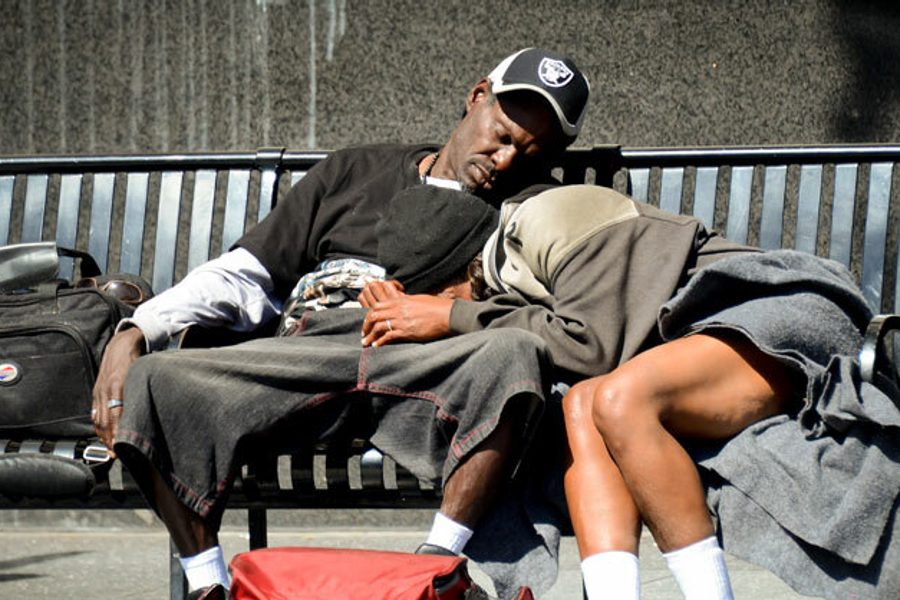A Bill of Rights for the Homeless
Several states are considering guaranteeing civil rights for those without a roof over their heads.
Amien Essif

After several years of unsuccessful attempts by advocacy organizations to define civil rights for the homeless at the federal level, Rhode Island became the first state to pass a Homeless Bill of Rights in June 2012, an amendment to its constitution that protects its residents against discrimination based on housing status. Now in Rhode Island, “no person’s rights, privileges, or access to public services may be denied or abridged solely because he or she is homeless.” And the law specifies where and when the homeless must be treated as any other Rhode Islander: in public parks, on public transportation, when seeking emergency medical care, when seeking employment, when registering to vote and when maintaining private records. What’s more, the personal property of the homeless must be treated “as personal property in a permanent residence.”
This past June, nearly identical Illinois and Connecticut bills passed through their state assemblies without much opposition. (The Illinois and Connecticut bills are not yet law, currently awaiting their governors’ signatures.) Homeless bills of rights introduced in Missouri, Oregon and Vermont are similar, though all three are pending in committee until the next legislative session.
Advocates claim that the bills provide a moral and legal foundation to challenge local anti-vagrancy policies. When the social safety net started to breech in the 1970s, and then all but gave way during the Reagan years, homelessness increased noticeably in the centers of American cities. Cuts in federal assistance to the poor — including mental healthcare and affordable housing — put people out on the streets. But as sociologist Teresa Gowan argues in her 2010 book Hobos, Hustlers and Backsliders: Homeless in San Francisco, rather than approach this crisis as a failure of society to take care of those in need, policymakers initiated “a crusade to save the homeless from themselves,” institutionalizing those who are willing to submit to treatment for drug addiction or mental illness, and criminalizing the rest under the “quality of life” laws that swept the country in the 1990s.
The past five years have seen another rise in homelessness. According to government statistics, the number of homeless families relying on shelters increased 30 percent between 2007 and 2009, a spike that the National Law Center on Homelessness and Poverty (NLCHP) attributes to the foreclosure crisis and widespread unemployment. At the same time, the NLCHP also found in a survey of 224 cities that between 2006 and 2009 there was a 7 percent increase in laws prohibiting “camping” on public property and an 11 percent increase in laws prohibiting loitering.
Sometimes the consequences are more serious than arrest. In March, Chicago public radio station WBEZ interviewed Jack King, whose blankets and other possessions were confiscated by police when he was forced out from his camp under a viaduct in the Uptown neighborhood. Six cold days after WBEZ interviewed King, he was found dead outside of an area health clinic. The cause of death was hypertension and heart disease, and many critics of city policy have pointed a finger at police for disrupting his camp and snatching his provisions.
Though the Illinois Homeless Bill of Rights might have prevented the police from taking his property without justification, it wouldn’t have given King the right to camp under the bridge.
A bill currently under consideration in California, however, would have let King sleep. The bill was introduced in December 2012 by Assemblyman Tom Ammiano (D-San Francisco), known for his work as a gay rights activist, and it has caught the attention of advocates across the country. The California bill — dubbed AB 5 — would give the homeless “the right to engage in life sustaining activities” on public property, including sleeping, panhandling and salvaging recyclables. If passed, the bill will effectively prune back municipal anti-vagrancy laws like San Francisco’s “Civil Sidewalks” ordinance, passed by referendum in 2010, that forbids sitting or sleeping on sidewalks in the daytime. The bill also includes an estimated $300 million budget that would establish hygiene centers and provide legal aid to challenge non-traffic citations, the category under which many vagrancy offenses fall.
In April, AB 5 passed the judiciary committee by a 7-2 vote. However, the bill didn’t make it out of the Appropriations Committee before the session’s end, and it will be held up until January 2014 due to concerns about the cost of enforcing the new bill.
The proposed legislation faces a large and organized opposition, including the business interests of California’s large cities. A Los Angeles Times editorial criticized the bill for sanctioning “a way of life that society generally agrees should be ended” and claimed that it would “turn the homeless into a protected class.” This criticism, however, doesn’t hold water for the bill’s advocates. Both Boden and Ammiano like to recite Anatole France’s wry observation that “the law, in its majestic equality, forbids the rich as well as the poor to sleep under bridges, to beg in the streets, and to steal bread.”
In Gowan’s opinion, whatever the outcome, homeless bills of rights from California to Rhode Island represent a shift in the conversation away from the notion that homelessness is a “side effect” of an individual pathology— and a return to the idea that society has a responsibility to provide full employment, affordable housing and mental healthcare.








